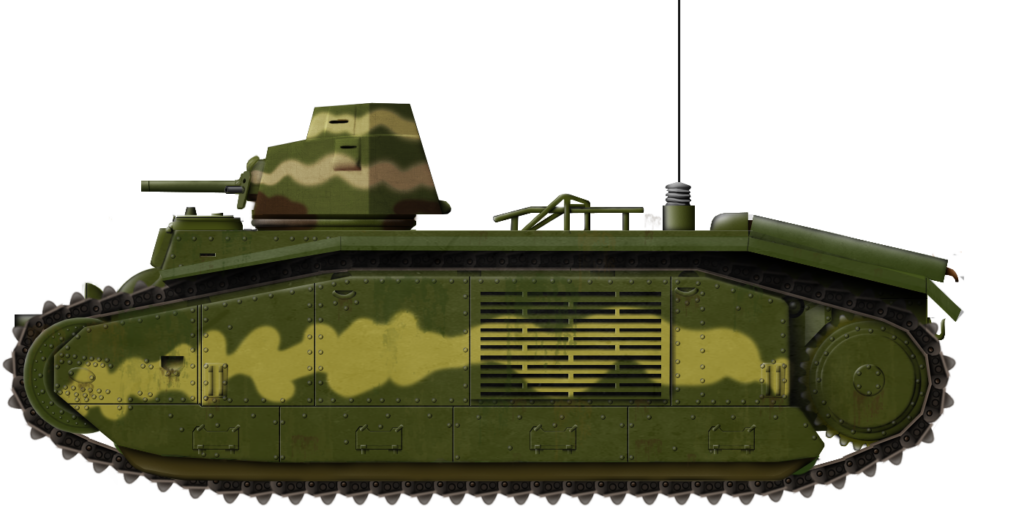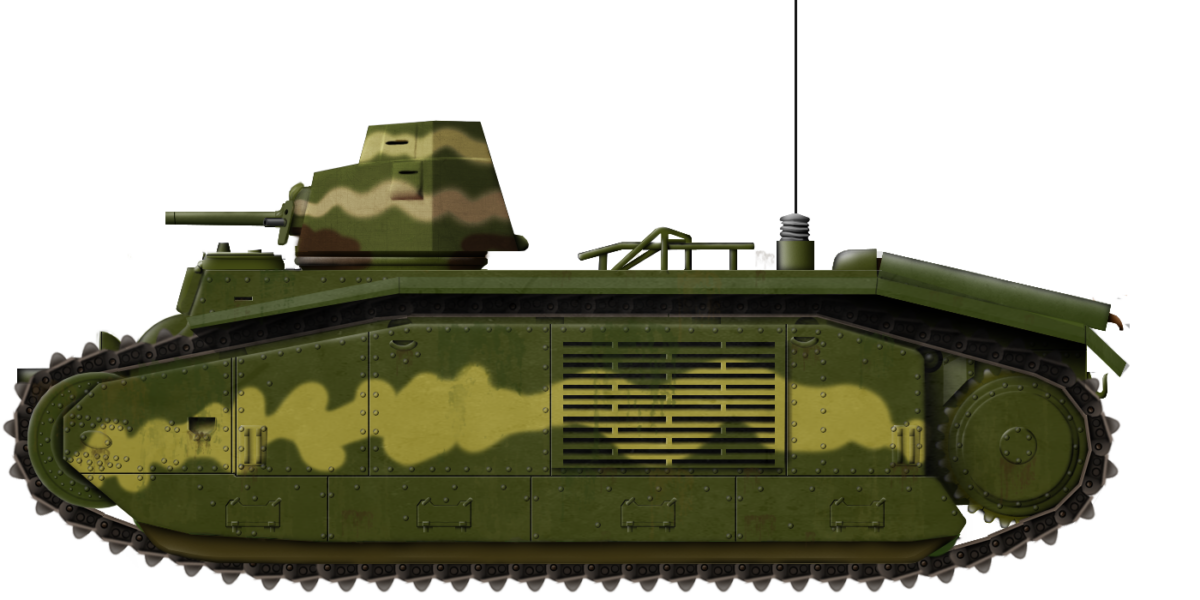 France (1938-1940)
France (1938-1940)
Heavy Infantry Tank – 1 Converted
During the 1930s, the French shipyard of FCM (Forges et Chantiers de la Méditerranée) was a fairly important player in the field of tank development and construction. In a field dominated by manufacturers using casting techniques and a few using riveting and bolting (mainly Renault and its cavalry vehicles), FCM was notable in its use of welding. Though this is mainly known via FCM’s only mass-produced design from the late 1930s, the FCM 36, FCM also studied a variety of heavier designs which used welding, such as the FCM F4 or FCM F1. FCM also took part in the studies to provide an improved version of the B1 Bis tank, of which FCM was one of several manufacturers, the B1 Ter. It is in this context that an experimental welded turret was given to a B1 Bis produced by FCM.
The B1 Bis “Marseille” and its Turret
The tank which received this new turret was the B1 Bis №234. It was assembled by FCM in early 1938 and would be delivered to the 510ème RCC (Régiment de Char de Combat – Combat Tank Regiment) in Nancy, Lorraine. There, it was nicknamed “Marseille”, after France’s second-largest city and a large Mediterranean harbor.
This B1 Bis was given a welded turret that had been designed by FCM. This welded turret appears to not have been an entirely new design, but was instead based on a design studied to provide a second, rear turret for FCM’s F4 tank.


In comparison to the FCM F4’s turret, the Marseille’s appears to have been merely a slightly simplified version. It remained a welded turret with 7 sides, including the front. The turret was designed to be similar to the APX 4 found on classic B1 Bis tanks in terms of general architecture. It therefore also retained the crew of one, the commander. The turret featured a commander cupola to the rear left, with three vision ports. If this cupola was given the observation devices of the standard B1 Bis, it would have had a PPL RX 160 episcope. However, the turret the Marseille received is known to have been more of a prototype/proof-of-concept, and may have lacked all the advanced features of a standard APX 4.
Vision ports were also found on the sides of the turret. They were more distinctive than on the standard B1 Bis’ APX 4, being more reminiscent of the APX 1 found on the older B1 in this fashion.
The armament of the FCM welded turret was the same as on a standard APX 4, a 47 mm SA 35 main gun to the right, and a coaxial MAC 31 7.5 mm machine gun to the left. The FCM turret featured different mantlets than the APX 4, owing to their use of welding instead of casting. This is particularly distinguishable on the machine gun, which appears to feature some kind of shield protecting it from enemy fire. As for the turret’s armor protection, it was very likely identical in thickness to the APX 4. The welding would have led to less angles and fewer rounded surfaces, but the stronger structural resistance of welded steel in comparison to cast steel would have likely made up for it.
The Point of the FCM Turret
Placing this new welded turret on a production Char B1 Bis which was then issued operationally was obviously a way for FCM to experiment with heavier welded turrets. Several motives can be found behind this.
An obvious one can be found in the form of FCM’s ongoing heavy tanks project. The company was, by 1938, involved in the B1 Ter program, which would later see FCM tasked with manufacturing a serial/pre-production vehicle, which FCM wanted to feature one of their own turrets instead of the APX 4 or even another welded design, the ARL 2. The FCM F4 program was also recent, and in early 1938, had evolved into the FCM F1 – which was also planned to feature a 47 mm-armed turret in addition to a much larger, 90 mm-armed one.
A more discrete but perhaps more realistic or at least short-term motive may also be found in the will to provide some competition to the APX 4 turret which outfitted all B1 Bis produced, including those by FCM. A common issue with French cast turrets (and even the non-cast ones, seeing as this was also an issue with the Panhard 178’s riveted APX 3) was that their production was typically slower than the hull they were to be mounted on, resulting in a backlog of completed hulls with no turret to be outfitted with – not too much of an issue in peacetime, but a much more considerable one in wartime. By proving it could produce its own turret – and likely have it be quicker to produce than the APX 4 for about equal performances – FCM may have hoped to see the army order FCM’s B1 Bis to use an FCM turret instead of those provided by the state manufacturer APX. This would not, however, materialize in any way.
The Fate of B1 Bis “Marseille” and of FCM’s Cast Turret
At the outbreak of the war, in September 1939, the B1 Bis “Marseille” became the tank of the commander of the French 15ème BCC (Bataillon de Char de Combat – Combat Tank Battalion). It was, at this point, retrofitted with the standard APX 4 turret. During the 1940 Campaign, it was passed between the 15th and the 8th battalions, where it again became the battalion commander’s tank in late May 1940. The tank notably took part in the Battle of Abbeville. It broke down on a road on the night of 5th to 6th June 1940. By mid-day on the 7th, it had still not been able to be recovered when it was attacked and captured by German infantry – putting an end to this peculiar B1 Bis’s service within the French Army.

As for FCM’s welded turret, the B1 Ter, which was to be produced by FCM, very likely had a turret very similar, if not directly based on the design which was found on Marseille. Sadly, no iconographic documents of FCM’s B1 Ter, may it be photos of the assembly process (the tank was being assembled by the time FCM’s facilities fell under Italian occupation) or plans, have survived. Out of the three B1 Ter prototypes, the FL one shares a similar fate, and only a very few photos of the ARL prototype’s hull during the assembly process have survived. The fate of the FCM B1 Ter is also unclear. While the ARL and FL prototypes were sunk during evacuation to North Africa in June of 1940, the FCM was still listed as in existence by an Italian report dated from July 1943. It vanished without a trace after this date, leaving its fate to be a mystery (though the exact nature of its resolution likely lays simply in identifying whether the hands that scrapped it were German during the occupation of Italy and Italy’s French occupation zone, or French, after the liberation of the country in 1944).

Sources
Char-français:
https://www.chars-francais.net/2015/index.php/14-classement-individuel/char-b/315-234-marseille
https://www.chars-francais.net/2015/index.php/7-archives/de-1930-1940/2427-1937-fcm-f4
https://www.chars-francais.net/2015/index.php/engins-blindes/chars?task=view&id=110
GBM 109, July-August-September 2014, “Le char B1 Ter”, pp 67-78


5 replies on “Char B1 Bis №234 “Marseille””
I understand that the turret kept the original 47mm cannon? There is no data chart either.
A small article but bringing an unknown topic to light. Another great job, Marisa.
A suggestion for TE: as a standard, articles about different versions of the same AFV, when possible, should present photos and/or blueprints side by side, showing the implemented differences.
The pic does not show the abandoblned Marseille tank because the turret is a cast one of the regular models
If you read the text, you would have found out that they retrofitted the old turret after the tests.
Can you tell me what the ‘K O’ stands for in the casting numbers?